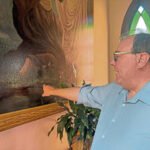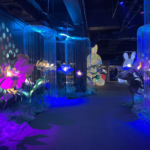
In a remote valley where art struggles for recognition, Zahoor and his team have carved a path—quite literally—into the world of international snow sculpting. Battling financial constraints and institutional apathy, they have defied expectations, proving that Kashmir’s artistry can stand tall, even on the world’s grandest frozen stages, Babra Wani reports

When India secured its first-ever bronze medal at an international snow sculpting competition, the landmark event was more than a victory. Making their debut on the global stage, the Indian team, led by Kashmiri sculptor Zahoor Din Lone, carved their way to recognition in Colorado, USA. This remarkable feat placed India firmly on the world map of snow sculpting.
An International Feat
India made history by clinching third place at the International Snow Sculpture Championship with its striking sculpture, Mind in Meditation, which captivated judges and spectators alike.
The four-member team—Zahoor Din Lone, Suhail Mohammad Khan, Mridul Upadhyay, and American resident Matt—worked relentlessly for four days in temperatures plummeting to -35°C. Suhail, a specially abled Kashmir sculptor, added another layer of inspiration to their success.
Despite harsh conditions and stringent time constraints, the team transformed a massive snow block into a breathtaking masterpiece. India ranked third in a competition that featured formidable contenders, with Germany securing first place and Mexico finishing second. Other participating teams included those from the USA, Finland, Canada, Mongolia, South Korea, Argentina, and Turkey. A panel of five judges took over six hours to evaluate at least 12 sculptures before determining the final rankings.
Lifelong Passion
Lead sculptor, Zahoor, 38, a resident of Sighpora, Pattan, recalled that in Kashmir, children get into this art by starting with making a snowman. He also got into the rare art the same way.
Gradually, he understood the nuances of this art form after he formally joined the Fine Arts department at the University of Kashmir, where he received professional training and earned a Bachelor’s degree. It was during his Master’s studies at Jamia Millia Islamia that he realised what Kashmiris colloquially referred to as sheen mohniv – or snowman, was a sophisticated art in Kashmir.
The Art of Snow Sculpting
Snow sculpting, Zahoor Din Lone explains, falls within the broader realm of sculpture, distinguished only by its ephemeral medium. Just as artists work with stone, wood, or clay, snow offers a unique, eco-friendly alternative. Unlike other materials, it leaves no waste and causes no pollution, yet its impermanence presents both a challenge and an artistic statement.
The process involves carving massive blocks of snow into intricate forms, akin to sand or ice sculpting. While largely practised outdoors, snow sculpting has gained recognition as a distinct artistic discipline.
At the University of Kashmir, Zahoor notes, the Fine Arts department offers three academic streams: applied arts, which focuses on visual design; painting; and sculpture, which explores various media, including snow. Interest in snow sculpting has grown, particularly with competitions and camps organised by the tourism department, which initially restricted participation to art students. In recent years, however, these events have been opened to participants from all academic backgrounds, providing a broader platform for aspiring artists.
“There are many students interested in snow sculpting,” Zahoor said. “Some reach out to me for guidance, and I always emphasise the need for institutional support. If the government provides a proper platform, we can train and mentor young artists, enabling them to compete at national and international levels.”
Kashmir’s Snow Art
Zahoor first experimented with snow sculpting in 2011. Inspired by the simple snowmen, Kashmir children build in villages each winter, he thought of taking itto next level. “I thought, if people create snowmen at home, why not elevate this form into a serious art practice? Why not take it to the international stage?”
His initial attempts, however, were unsuccessful. It was not until 2014 that a friend encouraged him to persist, offering both moral and financial support. “He told me that if we could establish snow sculpting as an art form in Kashmir, it would gain recognition and inspire others to take it forward.”
Buoyed by this encouragement, Zahoor gathered a group of 20 artists and founded Callisto Art and Culture, an organisation dedicated to fostering creative expression across disciplines. As captain of South Asia’s first competitive snow sculpting team, he sees Callisto as a space for critical thinking and artistic discourse, engaging with visual culture alongside literature, music, theatre, film, dance, architecture, and the performing arts.
“Callisto Art and Culture helps explain the world in which we live,” Zahoor said. “It provides a perspective and often challenges existing ideas, thoughts, and practices.”

A Journey from Nowhere
When Zahoor and his group first ventured into large-scale snow sculpting, they travelled to Gulmarg and organised an event, creating towering sculptures between 20 and 30 feet high. Without official backing, they relied on limited support from the tourism department. The event, however, attracted significant media attention, both locally and nationally, drawing public interest to their work.
Encouraged by the response, Zahoor set his sights higher. “I thought, since we are doing this in Kashmir, why not take it to the national level?” he recalled. The tourism department initially promised support, but no concrete assistance followed.
Disillusioned, Zahoor turned to independent research. “After facing multiple setbacks, I decided to explore opportunities on my own. That was when I discovered that what I envisioned for Kashmir was already a major discipline at the international level,” he said.
Determined to compete on the global stage, he began applying to international championships. His first attempt in 2015 was unsuccessful. The following year, his application remained on a waiting list. Forming a team proved another challenge. Since the competition required four members, he reached out to fellow artists, but none committed.
At the time, Zahoor was studying at Jamia Millia Islamia, where he befriended two students, one from Bihar and another from Madhya Pradesh. He shared his vision with them and invited them to join. “They were hesitant at first. They had never seen snow and had no understanding of it as an artistic medium,” he said. “I assured them that I would guide them. All they needed was to bring their artistic skills.”
An engineer, Mridul, soon joined the team, completing the four-member unit. Together, they resumed their efforts, applying again in 2017. They spent months studying competition guidelines—analysing designs, jury preferences, and artistic messaging—before settling on a concept: Indian Civilisation.
Then, they received the news they had been waiting for. “We were ecstatic,” Zahoor said. “Our friends called to inform us that we had been selected. Snow sculpting was a new concept for the region, and we were the only team from South Asia.”
The First Selection
Zahoor’s joy at being selected for the international championship was fleeting. “As soon as my friend said, Zahoor bhai, selection toh hogayi, lekin ab funds kahan se laayenge? Jaayenge kaise? (Brother Zahoor, we have been selected, but where will we get the funds? How will we go?), I was shattered,” he recalled. Competing in the United States required substantial financial resources—money they did not have.
The cost of purchasing specialised tools, travel expenses, and appropriate gear was far beyond the team’s means. “We approached different individuals and government departments, hoping for sponsorship,” Zahoor said. “But since nobody had heard of this art form, the response was the same everywhere—there were no funds for such a discipline.”
Just as they were losing hope, a professor at Jamia Millia Islamia offered them a different perspective. He reminded them that even securing a place in such a prestigious competition was an achievement. “Participation is a matter of destiny,” he told them. “If it is written, no one can take it away. If not, you have still accomplished something commendable.”
These words encouraged them to persist. Soon after, they met someone who directed them to a government official in Gurgaon. “He was one of the first people who responded positively,” Zahoor said. “Instead of dismissing us outright, he listened carefully and acknowledged our dedication and talent. However, he informed us that there were no government funds available, as none of us belonged to Haryana.”
Disheartened but not defeated, they left his office. Just as they reached the bus stop, his assistant called them back—the officer had found a sponsor. The next day, they met their benefactor, a builder, who agreed to cover their travel expenses.
“We finally made it to the United States,” Zahoor said. “But while we had funds for the journey, we could not afford all the necessary tools. We managed to get uniforms, but that was all.”
The First Challenge
Upon arrival, they were met with astonishment. Organisers, jury members, and fellow participants—many of whom had assumed that India, being a warm country, had no tradition of snow sculpting—were surprised to see them.
The competition site featured enormous cubes of snow, towering between 12 and 16 feet high. “We were stunned,” Zahoor said. “Until then, we had only worked on snow sculptures in Gulmarg. Seeing those massive blocks, we wondered—what next?”
The team soon realised that they were at a serious disadvantage. The tools they had brought from Kashmir, including axes, were ineffective against the densely packed snow, which was as hard as stone. “Our equipment failed,” he recalled. “Only the axes worked. People watched us, puzzled, wondering how we intended to carve anything with such rudimentary tools. We were visibly younger and less experienced than the other teams, many of whom were well-built professionals.”
Despite these setbacks, they pressed on. The complexity of their design and their lack of resources made it difficult to maintain structural balance. Their engineer friend, Mridul, applied his technical knowledge to stabilise the sculpture. Still, few believed they would succeed.
Exhausted but determined, they completed their sculpture, pushing themselves beyond their limits.
At the award ceremony, the team braced for disappointment. Then, to their disbelief, Team India was announced as the recipient of the Spirit Award. “We never expected it,” Zahoor said. “It was our first time competing, and we had no idea we would receive recognition. We jumped with joy.”
Expanding the Team
That moment marked the beginning of an unbroken journey. More artists joined their initiative, and they gradually formed multiple teams, each competing at different levels.
“Every year, we include a new member from Kashmir,” Zahoor said. “We want to provide young artists with the platform we struggled to find.”
Among the recruits was Suhail, a specially-abled artist. Zahoor, now a contractual faculty member in the Fine Arts department at the University of Kashmir, saw potential in him. “I believe in his ability,” he said. “I try to give him more opportunities.”
Since 2017, Zahoor and his team have participated in every major snow sculpting championship. “Except for the two years lost to Covid19,” he said, “we have never missed a single competition.”
The Challenges
For Zahoor, the greatest obstacle remains the absence of institutional support.
“At international competitions, we see participants from other countries fully sponsored,” he said. “They have professional uniforms, advanced equipment, and financial backing—resources we lack. This disparity holds us back.”
He believes that with proper support, their team could contend for the top prize. “I always say, if we had the right support, we could win gold too.”
Beyond financial constraints, there is a deeper issue: a lack of recognition for snow sculpting as an art form in Kashmir. While international audiences celebrate and cherish such artistic endeavours, Zahoor notes that in his home region, awareness remains limited.
“Governments and NGOs abroad invest substantial funds in sponsoring and organising these events,” he said. “Artists there are valued as highly as doctors and engineers.”
Zahoor and his team are determined to change that. Their current goal is to bring large-scale snow sculpting competitions to Kashmir. “We want to provide young artists with support and a platform,” he said. “This will not only boost their confidence but also contribute to the region’s tourism sector.”










